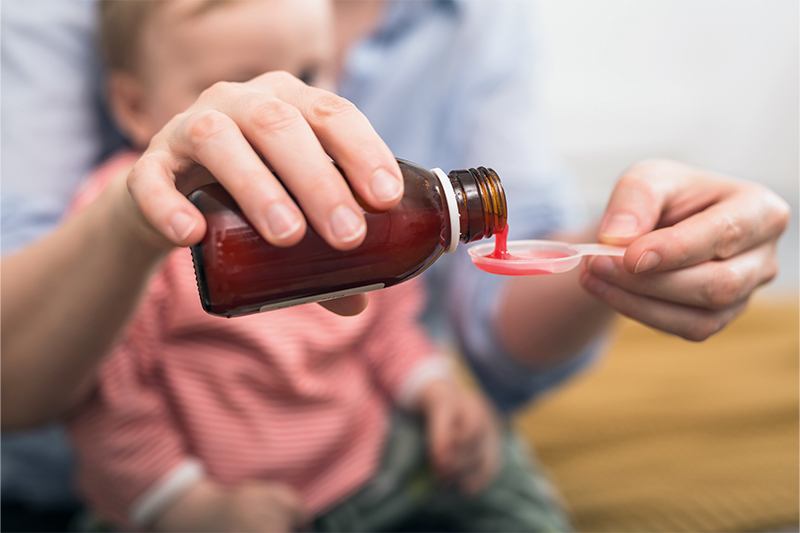Which pain medication is right for your child? What a pediatrician wants parents to know

There’s no shortage of safe and effective pain medications for children. Acetaminophen (commonly known as Tylenol), ibuprofen (Motrin, Advil), and naproxen (Aleve, Naprosyn) are the most common over-the-counter options, but how do you know which one is best to use when?
“Each pain medication has its own benefits and risks,” says Dr. Susan Harp, a pediatrician with Pediatric Associates of Hampden County. “Acetaminophen is commonly used for mild pain and fever relief. Ibuprofen is a good choice when your child has inflammation from an injury or infection or needs longer-lasting pain relief. Naproxen can be used for chronic or persistent pain and inflammation, but only for older children.”
With these distinctions in mind, here are some things Dr. Harp wants you to know about pain medication.
Acetaminophen
How it works: Acetaminophen works by blocking pain signals in the brain and reducing fever, but it doesn’t reduce inflammation. It can be given every four to six hours.
Best for:
- Mild to moderate pain relief for things like headaches or a sore throat
- Reducing fever
Things to know: Acetaminophen is processed in the liver, so it should be avoided in children who have liver conditions such as hepatitis. The liquid versions of acetaminophen for infants and older children now have the same strength (160 mg per 5 mL), so you don’t need a separate “infant” formula. However, always follow the package instructions to make sure you’re giving the right amount based on your child’s weight and age.
Ibuprofen (Advil, Motrin)
A warning about aspirin and Reye syndrome
Aspirin in any form should not be given to anyone under the age of 21 due to the risk of Reye syndrome, a rare but potentially life-threatening condition that causes swelling in the liver and brain. Only give aspirin to a child if instructed to do so by their doctor for very specific conditions such as congenital heart disease or rheumatoid arthritis.
How it works: Ibuprofen is a nonsteroidal anti-inflammatory drug (NSAID); it blocks the chemicals that cause pain and the enzymes that trigger the body’s inflammatory response to an injury or infection. Ibuprofen lasts longer than acetaminophen, so it can be given every six to eight hours.
Best for:
- Pain that comes with inflammation, such as muscle sprains or strains
- Pain caused by things like ear infections or teething
Things to know: Ibuprofen can irritate the stomach and, because it’s processed by the kidneys, can pose a risk of kidney damage in children who are dehydrated or who have kidney conditions. Ibuprofen should not be given to babies younger than 6 months. For children with asthma, ibuprofen may worsen breathing or trigger an asthma attack, so use with caution. Infant ibuprofen may be more concentrated than the children’s liquid version, so it’s important to use the correct dosing tool for your child’s age.
Naproxen (Aleve)
How it works: Naproxen is also an NSAID, but it lasts up to 12 hours, so it’s a good option for chronic pain, such as arthritis.
Best for:
- Chronic pain associated with conditions such as arthritis, injuries, muscle pain
- Children 12 and older
Things to know: Naproxen carries similar risks as ibuprofen, including gastrointestinal problems and kidney damage, especially with prolonged use. Use the lowest effective dose for the shortest time necessary.
Switching between medications for better pain relief
Alternating between acetaminophen and ibuprofen is common, but it doesn’t always offer better pain relief. It can also make it harder to keep track of doses. If you decide to alternate, be sure to note when and what you gave to avoid overdosing. You can also give both medications at the same time for more severe pain, up to every six hours.
Avoid over-use
If your child has a common illness like the flu with a fever, it’s fine to give pain medication for up to five days. Otherwise, do not give over-the-counter pain medication for more than three days in a row or more than three days a week, unless advised by your child’s doctor for a serious condition or after surgery. Too much pain medication can cause problems and may even worsen chronic headaches.
Choosing the right medication
The right pain relief for your child depends on their individual needs, age, and how they respond to each medication. This includes how well it relieves their pain, any potential side effects, and how long it lasts. Dr. Harp reminds parents of the most important factor: “Follow dosing instructions. If you’re not sure how much or how often to give medicine — especially if your child is really young or has an underlying health condition — check with your pediatrician.”
Learn more about Boston Children’s Primary Care Alliance or find a primary care practice near you.
Related Posts :
-

Emergency department or urgent clinic? Understanding your options if your child is injured
Having an active or adventurous child often means comforting them when they come home with bumps or bruises. But when ...
-

Five ways to help manage your child's asthma this school year
While fall is a time of considerable change for children — a new school year with new challenges — it can also ...
-

Chronic headaches: Five things families should know
You might think of headaches as an adult problem, but they can affect children and teens, too. In fact, about 20 ...
-

What every family should know about RSV
To help keep your family safe and informed about respiratory syncytial virus (RSV), we spoke to Dr. Kathleen Conroy, Clinical ...





